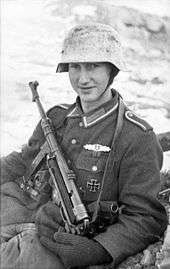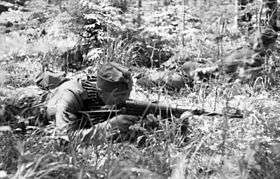MP 40
| MP 40 | |
|---|---|
|
Maschinenpistole 40 | |
| Type | Submachine gun |
| Place of origin | Nazi Germany |
| Service history | |
| In service | 1938–1945 (Nazi Germany) |
| Used by | See Operators |
| Wars | |
| Production history | |
| Designer | Heinrich Vollmer |
| Designed | 1938 |
| Manufacturer | |
| Produced | 1940–1945 |
| No. built | 1,100,000 (estimated) |
| Variants |
|
| Specifications | |
| Weight | 3.97 kg (8.75 lb)[2][3] |
| Length | 833 mm (32.8 in) stock extended / 630 mm (24.8 in) stock folded[4] |
| Barrel length | 251 mm (9.9 in)[4] |
|
| |
| Cartridge | 9×19mm Parabellum[4] |
| Action | Straight blowback, open bolt[3] |
| Rate of fire | 500–550 rounds/min[4] |
| Muzzle velocity | 400 m/s (1,312 ft/s)[4] |
| Effective firing range | 100 – 200 m[3] |
| Maximum firing range | 250m[3] |
| Feed system | 32-round detachable box magazine, 64-round with dual magazines[3] |
| Sights | Hooded front blade |
The MP 40 (Maschinenpistole 40) was a submachine gun chambered for the 9×19mm Parabellum cartridge. It was developed in Nazi Germany and used extensively by the Axis powers during the Second World War.
Designed in 1938 by Heinrich Vollmer with inspiration from its predecessor the MP 38, it was heavily used by infantrymen (particularly platoon and squad leaders), and by paratroopers, on the Eastern and Western Fronts. Its advanced and modern features made it a favorite among soldiers and popular in countries from various parts of the world after the war. It was often erroneously called "Schmeisser" by the Allies, although Hugo Schmeisser was not involved in the design or production of the weapon. From 1940 to 1945, an estimated 1.1 million were produced by Erma Werke.
Development

The Maschinenpistole 40 ("Machine pistol 40") descended from its predecessor the MP 38, which was in turn based on the MP 36, a prototype made of machined steel.[5] The MP 36 was developed independently by Erma Werke's Berthold Geipel with funding from the German Army. It took design elements from Heinrich Vollmer's VPM 1930 and EMP. Vollmer then worked on Berthold Geipel's MP 36 and in 1938 submitted a prototype to answer a request from the Heereswaffenamt (Army Weapons Office) for a new submachine gun, which was adopted as MP 38. The MP 38 was a simplification of the MP 36, and the MP 40 was a further simplification of the MP 38, with certain cost-saving alterations, most notably in the more extensive use of stamped steel rather than machined parts.[5]
The MP 40 was often called the "Schmeisser" by the Allies, after the weapon designer Hugo Schmeisser. Schmeisser had designed the MP 18, which was the first mass-produced submachine gun in the world, and carried some resemblance to the MP 40. He did not, however, have anything to do with the design or development of the MP 40, although he held a patent on the magazine.[6]
Design
The MP 40 submachine guns are open-bolt, blowback-operated automatic arms. The only mode of fire was fully automatic, but the relatively low rate of fire enabled single shots with controlled trigger pulls.[7] The bolt features a telescoping return spring guide which serves as a pneumatic recoil buffer.[7] The cocking handle was permanently attached to the bolt on early MP 38s, but on late production MP 38s and MP 40s, the bolt handle was made as a separate part.[8] It also served as a safety by pushing the head of handle into one of two separate notches above the main opening; this action locked the bolt either in the cocked (rear) or uncocked (forward) position.[8] The absence of this feature on early MP 38s resulted in field expedients such as leather harnesses with a small loop, used to hold the bolt in forward position.[9]
The MP 38 receiver was made of machined steel, but this was a time-consuming and expensive process.[10] To save time and materials, and thus increase production, construction of the MP 40 receiver was simplified by using stamped steel and electro-spot welding as much as possible. [10] The MP 38 also features longitudinal grooving on the receiver and bolt, as well as a circular opening on the magazine housing. These features were eliminated on the MP 40.[10]

One unique feature found on most MP 38 and MP 40 submachine guns was an aluminum, steel, or bakelite resting bar or support under the barrel. This was used to steady the weapon when firing over the side of open-top armored personnel carriers such as the Sdkfz 251 half-track. A handguard, made of a synthetic material derived from bakelite, was located between the magazine housing and the pistol grip.[11] The barrel lacked any form of insulation, which often resulted in burns on the supporting hand if it was incorrectly positioned.[11] The MP 40 also had a forward-folding metal stock, the first for a submachine gun, resulting in a shorter overall weapon when folded.[12] However, this stock design was at times insufficiently durable for hard combat use.[12]
Although the MP 40 was generally reliable, a major weakness was its 32-round magazine.[13] Unlike the double-column, dual-feed magazine insert found on the Thompson M1921-28 variants, the MP 40 used a double-column, single-feed insert.[13] The single-feed insert resulted in increased friction against the remaining cartridges moving upwards towards the feed lips, occasionally resulting in feed failures; this problem was exacerbated by the presence of dirt or other debris.[13] Another problem was that the magazine was also sometimes misused as a handhold.[14] This could cause the weapon to malfunction when hand pressure on the magazine body caused the magazine lips to move out of the line of feed, since the magazine well did not keep the magazine firmly locked.[14] German soldiers were trained to grasp either the handhold on the underside of the weapon or the magazine housing with the supporting hand to avoid feed malfunctions.[14]
Usage
At the outbreak of World War II, the majority of German soldiers carried either Karabiner 98k rifles or MP 40s, both of which were regarded as the standard weapons of choice for an infantryman.[15]
However, later experience with Soviet tactics, such as the Battle of Stalingrad where entire Russian units armed with submachine guns outgunned their German counterparts in short range urban combat, caused a shift in tactics, and by the end of the war the MP 40 and its derivatives were being issued to entire assault platoons on a limited basis.[16] Starting in 1943, the German Army moved to replace both the Karabiner 98k rifle and MP 40 with the new, revolutionary StG 44.[16][15] By the end of World War II (which ended in 1945), an estimated 1.1 million MP 40s had been produced of all variants.[17]
Post-war usage
During and after the end of World War II, many MP 40s were captured or surrendered (upwards of 200,000) to the Allies and were then redistributed to the paramilitary and irregular forces of some developing countries.[18] The Norwegian army withdrew the MP 38 from use in 1975 but used the MP 40 for some years more. In particular, the Territorials (Heimevernet) used it until about 1990, when it was replaced by the Heckler & Koch MP5.[9]
Variants
MP 40/I
A modified version of the standard MP 40 (sometimes erroneously called MP 40/II) with a dual side-by-side magazine holder (for a theoretical ammunition total of 64 rounds), designed for special operations troops on the Eastern Front to compensate for the enemies' PPSh-41 larger magazine capacity. However, the design proved unsuccessful due to weight and reliability issues.
MP 41

In 1941, Hugo Schmeisser designed the MP 41, which was in reality an MP 40 with a wooden rifle stock, selector and trigger mechanism, identical to those found on the earlier MP 28 submachine gun. It saw limited service, however, and was issued only to SS and police units in 1944. The MP 41 was also supplied to Germany's Axis ally Romania.[19]
Civilian ownership
United States
Following the Allied occupation of Europe in 1945, U.S. servicemen shipped home thousands of captured firearms as war trophies,[20] including MP 40s. This practice required proper registration of automatic weapons in accordance with the National Firearms Act before they could be imported, but this was curtailed later in the occupation, meaning a relatively small number of civilian-transferable MP 40 remain in circulation and are valued around $15,000 as of 2017.[21]
There are several semi-automatic variants and cosmetic replicas of the MP 40 available for civilian ownership in the U.S. Beginning in 2014, American Tactical Imports began importing a MP 40 replica manufactured by German Sporting Guns GmbH chambered in .22LR,[22] and since 2016 has also imported a pistol variant chambered in 9mm.[23] The .22LR variant features an all-metal construction with period-accurate Bakelite furniture, a folding stock, and a faux-suppressor to meet barrel length import requirements. The 9mm variant is classified as a pistol and therefore does not ship with a folding stock. Both variants are closed-bolt, blowback-operated semi-automatic firearms that vary substantially from originally manufactured MP 40s in internal operations, making them more of affordable cosmetic replicas than faithful reproductions. Neither of the GSG-manufactured variants are compatible with originally manufactured MP 40 parts and magazines.
Operators

During World War II, anti-Nazi resistance fighters and Allied soldiers sometimes captured MP 40s to replace or supplement their own weapons.[24][25][26]
The MP 40 was used for several decades following World War II by many countries around the world in armed conflicts. Captured MP40s found their way into guerrilla groups such as the Viet Cong or African guerrillas. Also, the MP 40 was used in the 2011 Libyan Civil War and the Syrian Civil War.[27][9]


.svg.png)







.svg.png)






.svg.png)




.svg.png)




.svg.png)
See also
Footnotes
- ↑ Used in the 1948 Arab–Israeli War and afterwards by Unit 101 until replaced by the Uzi.[27]
References
- ↑ Medal Net.
- ↑ Hogg 2001, p. 16.
- 1 2 3 4 5 Fowler 2005, p. 98.
- 1 2 3 4 5 Myatt & Ridefort 1992, p. 107.
- 1 2 de Quesada 2014, p. 13.
- ↑ Rottman 2012, p. 9.
- 1 2 Peterson 2011, p. 314.
- 1 2 Bishop 2002, p. 259.
- 1 2 3 World Guns.
- 1 2 3 de Quesada 2014, p. 17.
- 1 2 Hobart 1975, pp. 95–98.
- 1 2 Hogg & Weeks 1977, p. 90.
- 1 2 3 Hogg & Weeks 1977, p. 33.
- 1 2 3 Dunlap 1966, pp. 80–81.
- 1 2 Neil 2015, p. 65.
- 1 2 Priestley & Cavatore 2014, pp. 105–108.
- ↑ Willbanks 2004, p. 82.
- ↑ Ingram 2001, p. 75.
- ↑ Axworthy 1991, p. 42.
- ↑ "Chapter XVIII: The Occupation Troops". history.army.mil. Retrieved 2018-01-05.
- ↑ "Subguns - Machine Gun Price Guide". machinegunpriceguide.com. Retrieved 2018-01-05.
- ↑ Grant, Jim (2014-01-19). "ATI's GSG MP40, the quintessential bad-guy gun". Guns.com. Retrieved 2018-01-05.
- ↑ Johnson, Steve (2016-02-24). "BREAKING NEWS: ATF Approve ATI MP40 9mm Pistol (Pistol Version of German WWII MP40 Submachine Gun) - The Firearm Blog". The Firearm Blog. Retrieved 2018-01-05.
- 1 2 Sakaida, Henry (May 20, 2003). Hook, Christa, ed. Heroines of the Soviet Union 1941-45. Bloomsbury Publishing. p. 59. ISBN 1841765988.
- 1 2 Cornish, Nik (June 20, 2014). Karachtchouk, Andrei, ed. Soviet Partisan 1941-45. Bloomsbury Publishing. p. 29. ISBN 9781472801456.
- ↑ Weckstein, Leon (2011). 200,000 Heroes: Italian Partisans and the American OSS in WWII. Hellgate Press. p. 233. ISBN 9781555716981.
- 1 2 3 Katz 1988, p. 9.
- ↑ Windrow, Martin (1997). The Algerian War, 1954-62. Men-at Arms 312. London: Osprey Publishing. pp. 10&37. ISBN 978-1-85532-658-3.
- 1 2 3 4 5 6 de Quesada 2014, p. 66.
- 1 2 3 de Quesada 2014, p. 64.
- 1 2 3 4 5 6 de Quesada 2014, p. 77.
- ↑ Brnardic, Vladimir (November 17, 2016). Aralica, Višeslav, ed. World War II Croation Legionaries: Croation Troops Under Axis Command 1941—45. Bloomsbury Publishing. p. 17. ISBN 978-1-4728-1767-9.
- ↑ Windrow, Martin (15 Nov 1998). The French Indochina War 1946–54. Men-at-Arms 322. Osprey Publishing. p. 12. ISBN 9781855327894.
- ↑ "L'armement français en A.F.N." Gazette des Armes (in French). No. 220. March 1992. pp. 12–16.
- ↑ Tibor, Rada (2001). "Német gyalogsági fegyverek magyar kézben" [German infantry weapons in Hungarian hands]. A Magyar Királyi Honvéd Ludovika Akadémia és a Testvérintézetek Összefoglalt Története (1830-1945) (in Hungarian). II. Budapest: Gálos Nyomdász Kft. p. 1114. ISBN 963-85764-3-X.
- ↑ de Quesada 2014, p. 69.
- ↑ de Quesada 2014, p. 67.
- ↑ de Quesada 2014, p. 20.
- ↑ de Quesada 2014, p. 56.
- ↑ de Quesada 2014, p. 23.
- ↑ Williams, Anthony G.; Popenker, Maxim (January 15, 2012). Sub-Machine Gun: The Development of Sub-Machine Guns and their Ammunition from World War 1 to the Present Day. Crowood Press UK. p. 15. ISBN 1847972934.
- ↑ David Campbell (2016). Israeli Soldier vs Syrian Soldier : Golan Heights 1967–73. Combat 18. illustrated by Johnny Shumate. Osprey Publishing. p. 10. ISBN 9781472813305.
- ↑ JWH1975 (June 23, 2017). "Syrian Civil War: WWII weapons used". WII After WII. Wordpress. Retrieved April 6, 2018.
- ↑ Rottman, Gordon L. (25 Jul 2002). Green Beret in Vietnam 1957–73. Warrior 28. Osprey Publishing. p. 41. ISBN 9781855325685.
Sources
Printed
- Axworthy, Mark (1991). The Romanian Army of World War II. Osprey Publishing. ISBN 978-1855321694.
- Bishop, Chris (2002). The Encyclopedia of Weapons of World War II. Sterling Publishing Company, Inc. ISBN 978-1586637620.
- Dunlap, Roy (1966). Ordnance Went Up Front. R & R Books. ISBN 978-1884849091.
- Fowler, William (2005). Stalingrad, the Vital Seven Days. Spellmount. ISBN 978-1862272781.
- Hobart, Frank (1975). Pictorial History of the Sub-machine Gun. Scribner Publishing. ISBN 978-0684141862.
- Hogg, Ian; Weeks, John, eds. (1977). Military Small Arms of the 20th Century. Arms & Armour Press. ISBN 0-85368-301-8.
- Hogg, Ian (2001). Submachine Guns. Greenhill Books. ISBN 978-1853674488.
- Ingram, Mike (2001). The MP40 Submachine Gun. Zenith Imprint. ISBN 0-7603-1014-9.
- Katz, Samuel (1988). Israeli Elite Units Since 1948. Osprey Publishing. ISBN 0-85045-8374.
- Myatt, Frederick; Ridefort, Gerard, eds. (1992). New Illustrated Guide to Modern Rifles & Sub-Machine Guns. Smithmark Publishing. ISBN 978-0831750558.
- Neil, Grant (2015). Mauser Military Rifles. Osprey Publishing. ISBN 978-1472805942.
- Peterson, Philip (2011). Standard Catalog of Military Firearms: The Collector's Price and Reference Guide. F+W Media, Inc. ISBN 978-1440228810.
- Priestley, Rick; Cavatore, Alessio, eds. (2014). Bolt Action: World War II Wargames Rules. Osprey Publishing. ISBN 978-1782009702.
- de Quesada, Alejandro (2014). MP 38 and MP 40 Submachine Guns. Osprey Publishing. ISBN 978-1780963884.
- Rottman, Gordon L (2012). The AK-47: Kalashnikov-series Assault Rifles. Osprey Publishing. ISBN 978-1-84908-835-0.
- Willbanks, James (2004). Machine Guns: An Illustrated History of Their Impact. ABC-CLIO. ISBN 978-1851094806.
Online
- "Erma MP-38 and MP-40 submachine gun (Germany)". World Guns. Retrieved 7 March 2015.
- "MP40 Manufacturers and Markings". Medal Net. Retrieved 7 March 2015.
External links
| Wikimedia Commons has media related to MP40. |
| Wikimedia Commons has media related to MP41. |